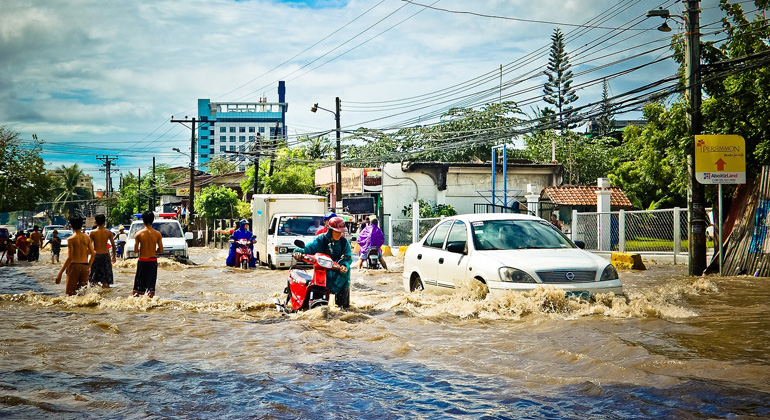(Un)Natural Disasters: Communicating Linkages Between Extreme Events and Climate Change
The science of attributing extreme weather and climate events has progressed in recent years to enable an analysis of the role of human causes while an event is still in the media.
However, there is still widespread confusion about the linkages between human-induced climate change and extreme weather, not only among the public, but also among some meteorologists and others in the scientific community. This is an issue of communication as well as of science. Many people have received the erroneous message that individual extreme weather events cannot be linked to human-induced climate change, while others attribute some weather events to climate change where there is no clear evidence of linkages. In order to advise adaptation planning and mitigation options, there is a need to communicate more effectively what the most up-to-date science says about event attribution, and to include appropriate information on linkages when reporting extreme weather and climate events in the media. This article reviews these issues, advancements in event attribution science, and offers suggestions for improvement in communication.
The weather seems to be getting wilder and weirder. People are noticing. What are the connections to human-caused climate change? And how can we best communicate what the most recent science is telling us about human-induced and natural changes to weather and climate?
When heavy rains led to devastating floods in the United Kingdom (UK) in January 2014, the then Prime Minister David Cameron stated that he “very much suspects” the floods were linked to climate change. A scientific analysis had concluded that climate change had increased the chances of the rainfall that caused the flooding by an estimated 43% (Schaller et al, 2016). The fact is that warmer air holds more moisture, which generally leads to heavier rainfall. The potential for damage from such extreme events is also increasing, as higher river levels put more properties at risk from flooding; the 2014 UK floods cost US$ 646 million (£451 million) in insurance losses, one of the highest in history (Schaller et al, 2016).
In Australia, the summer of 2013 was the hottest on record. The sustained high temperatures were linked to bushfires in the country’s southeast and severe flooding in its northeast. Conditions were so severe it was dubbed “the angry summer” (Steffen, 2013). According to a scientific analysis, the record heat that summer was made at least five times more likely – a 500% increase in the odds of it occurring – by human-caused warming. This conclusion, using the observed temperature record and climate models, was made with more than 90% confidence (Lewis and Karoly, 2013).
The 2014 UK flooding and 2013 Australian heat wave are just two recent extreme events that scientists have determined were considerably more likely to occur due to human-caused climate change. Such heat waves and heavy downpours are among the classes of extreme events that tend to be more frequent and/or more severe in a warmer world.
But not all extremes are increasing. For example, there has been an overall decrease in the number of very cold days and nights, as would be expected in a warming world. Still, the Intergovernmental Panel on Climate Change (IPCC) in its 2012 report on extremes wrote: “A changing climate leads to changes in the frequency, intensity, spatial extent, duration, and timing of extreme weather and climate events, and can result in unprecedented extreme weather and climate events” (Field et al, 2012). Nonetheless, scientific findings that specific extreme weather and climate events can, in fact, be attributed to human-caused climate change have not been widely reflected in public understanding.
Lost in translation
While scientists have known for decades that changes in some classes of extreme weather would result from climate change, the science of attributing individual extreme events to global warming has only advanced significantly in recent years to cover a greater number of extremes and achieve a greater speed of scientific analysis. Unfortunately, the communication of this science outside the extreme event research community has, with a few notable exceptions, not fully reflected these advances. The media, politicians and some scientists outside this area of research still often claim that “we can’t attribute any individual event to climate change.” This may have been true in the 1990s, but it is no longer the case.
Part of the problem is that for a long time many scientists themselves repeated this message. They stuck to the generic explanation that many of the extreme weather events witnessed in recent years were consistent with projections of climate change, although the science had moved well beyond this general explanation to specific event attribution. However, there are some cases in which scientists can say more about attributing the underlying factors behind an extreme event than about the specifics of the event itself. This complexity can create confusion and lead to missed communication opportunities. Hence, it is not surprising that it is taking a while for public awareness to catch up with the science.
Another issue for communication is that the response of the climate system to warming includes intensifying the water cycle, leading, for example, to both more droughts and more floods. If the mechanisms by which this occurs – that is higher air temperatures dry out soils, and a warmer atmosphere holds more moisture leading to heavier precipitation – are not explained to non-scientists, the combination of both wetter and drier conditions can seem counter-intuitive.
Furthermore, the causes of specific extremes can be seen as politically charged in some countries where, unfortunately, climate change has become a partisan issue. For example, in the aftermath of an extreme event, such as a fire or flood, some people may see it as insensitive and/or political to discuss human-induced causes of loss of life or property.








